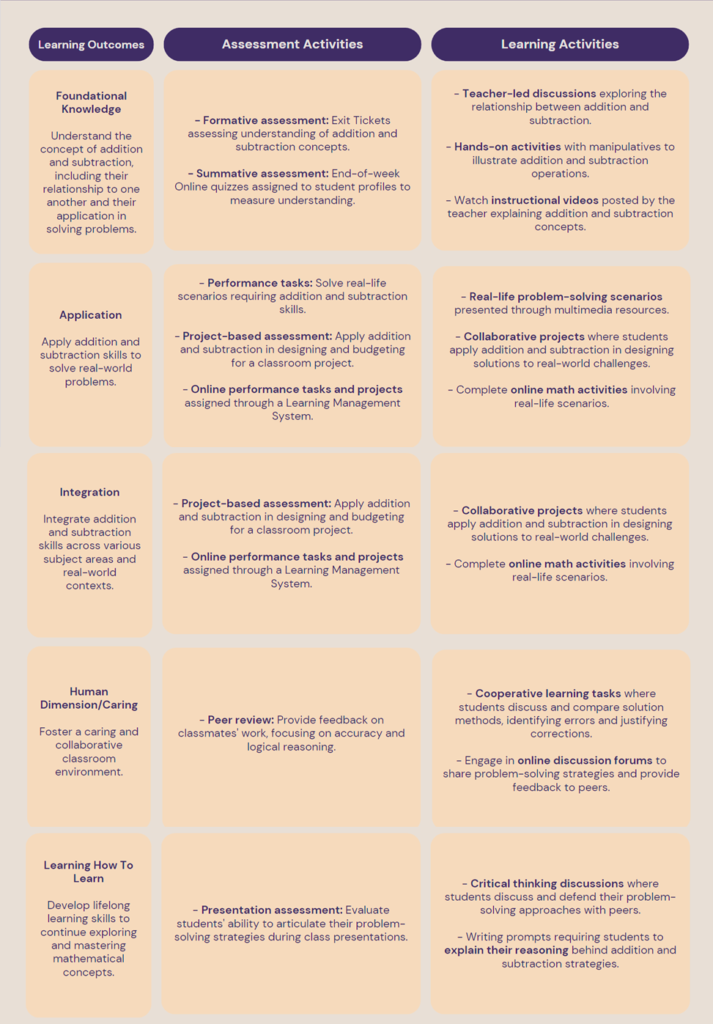Math Hybrid Course
Access presentation script here
Subject
- Mathematics (Addition and Subtraction)
Level of instruction
- Third Grade.
Intended audience
- Students enrolled in the third-grade class, who may come from diverse socio-economic backgrounds and have varying levels of prior mathematical knowledge and experience.
Key institutional documents influencing design process
- District Math Curriculum: Provides guidelines and standards for what students should learn and how it should be taught, ensuring alignment with state educational objectives and benchmarks.
- District Exemplar Lessons: Offers examples of effective teaching strategies, instructional materials, and assessment methods, serving as a model for educators to follow.
Design approach
The chosen design approach is Blended Learning, combining face-to-face instruction with online learning components. Blended Learning accommodates diverse learning preferences and needs, enabling students to engage with content in multiple formats and at their own pace. Moreover, it facilitates parental involvement by providing access to online resources and insights into instructional methods, enhancing collaboration between home and school.
Control of learning
In this student-centered approach, the teacher acts as a facilitator and mentor, empowering students to take ownership of their learning. By providing opportunities for choice, autonomy, and voice, students are motivated to explore, inquire, and construct knowledge in meaningful ways. Through an authentic learning environment, students develop essential skills such as critical thinking, problem-solving, and collaboration, preparing them for success in both academic and real-world contexts.
Competency-based education (CBE) or outcome-based education (OBE)
The design integrates elements of both competency-based education (CBE) and outcome-based education (OBE) to ensure comprehensive learning outcomes. CBE emphasizes mastery of specific skills and competencies, while OBE focuses on achieving desired learning outcomes. By combining these approaches, the course promotes both skill acquisition and conceptual understanding, fostering deeper engagement and application of mathematical concepts.
Balancing assessment
Assessment strategies encompass a variety of approaches, including summative assessments (assessment of learning), formative assessments (assessment for learning), and self-assessment (assessment as learning). Summative assessments evaluate student mastery of addition and subtraction concepts, providing feedback on overall performance. Formative assessments offer ongoing feedback to guide instruction and support student learning, while self-assessment opportunities empower students to reflect on their progress, set goals, and monitor their own learning journey.
Moving learners into deeper learning
The design is intentionally crafted to promote deeper learning by engaging students in activities that encourage critical thinking, problem-solving, and application of mathematical concepts in real-world contexts. Through hands-on tasks, collaborative projects, and inquiry-based learning experiences, students develop a deeper understanding of addition and subtraction, moving beyond rote memorization to meaningful comprehension and transferable skills acquisition.
Outline
Week 1: Review of Second-Grade Concepts
- Day 1: Review of addition and subtraction concepts from second grade through teacher-led discussions and interactive activities. Introduction to the course objectives and expectations.
- Day 2: Hands-on activities with manipulatives to reinforce addition and subtraction concepts. Online quiz assigned to assess students’ baseline understanding.
- Day 3: Further exploration of addition and subtraction relationships through collaborative problem-solving tasks. Introduction to the blended learning format and online resources.
- Day 4: Review and practice addition and subtraction facts through daily math drills and partner activities. Discussion on the importance of fluency in basic operations.
- Day 5: Formative assessment: Reflective writing prompts where students explain their reasoning behind addition and subtraction strategies. Review of the week’s concepts and preparation for upcoming lessons.
Week 2: Building Foundational Knowledge
- Day 1: Introduction to the concept of addition, including basic strategies and properties. Teacher-led discussions and online videos.
- Day 2: Practice addition facts through online math activities and partner games. Online quiz to assess understanding.
- Day 3: Exploration of subtraction concepts and strategies through hands-on activities and problem-solving tasks.
- Day 4: Application of addition and subtraction skills in real-world contexts, such as money problems and measurement conversions.
- Day 5: Formative assessment: Peer review of problem-solving approaches in critical thinking discussions. Review and reinforcement of the week’s concepts.
Week 3: Developing Fluency
- Day 1: Daily math drills to build speed and accuracy in mental addition and subtraction. Online fluency quizzes assigned.
- Day 2: Further practice with addition and subtraction facts through online activities and games. Peer collaboration on challenging problems.
- Day 3: Introduction to regrouping in addition and subtraction. Guided practice exercises and interactive online tutorials.
- Day 4: Application of regrouping strategies in solving multi-digit addition and subtraction problems. Real-life scenarios presented for problem-solving.
- Day 5: Formative assessment: Timed fluency quizzes to measure progress. Reflective writing prompts on strategies for efficient computation.
Week 4: Applying Skills to Real-World Problems
- Day 1: Collaborative projects where students apply addition and subtraction skills to design and budget for a classroom project. Online project-based assessment assigned.
- Day 2: Problem-solving scenarios involving real-life situations, such as shopping or building projects. Peer review and feedback on solutions.
- Day 3: Further application of addition and subtraction in measurement and geometry problems. Online performance tasks assigned.
- Day 4: Integration of addition and subtraction skills with other subject areas, such as science or social studies. Cross-curricular projects.
- Day 5: Formative assessment: Presentation of projects and problem-solving approaches in a classroom showcase. Reflection on real-world applications of math skills.
Week 5: Reflection and Review
- Day 1: Review of addition and subtraction concepts covered throughout the unit. Online review quizzes assigned to reinforce learning.
- Day 2: Reflection on personal growth and learning achievements in addition and subtraction. Self-assessment and goal setting.
- Day 3: Application of addition and subtraction skills in challenging problem-solving tasks. Online performance tasks to demonstrate proficiency.
- Day 4: Culminating activity: Collaborative problem-solving challenges and games. Celebration of accomplishments.
- Day 5: Final assessment: Summative quiz to evaluate mastery of addition and subtraction concepts. Reflection on learning journey and future math goals.
This weekly outline structures the 5-week math unit on addition and subtraction, incorporating a review of second-grade concepts in the first week and progressively building students’ understanding and fluency over the following weeks through a blend of hands-on activities, online resources, and real-world applications.
3-Column Table
Big Hairy Audacious Goal (BHAG): To empower third-grade students to become confident, proficient mathematicians who can apply addition and subtraction skills with ease and fluency, both in academic settings and real-life situations, fostering a lifelong love for mathematics.
* Click on image to enlarge.

Syllabus
Course: Third Grade Addition and Subtraction.
Instructor: William Tavares
Contact Information: [wtavares@gmail.com] | [555-555-5555]
Course Description:
This course is designed to enhance students’ understanding and proficiency in addition and subtraction operations. Through a blend of hands-on activities, collaborative projects, and online resources, students will explore the foundational concepts of addition and subtraction, develop fluency in basic operations, and apply their skills to real-world problem-solving scenarios.
Course Objectives:
- Understand the concept of addition and subtraction, including their relationship to one another.
- Develop fluency in performing addition and subtraction of numbers up to 1,000 accurately and efficiently.
- Apply addition and subtraction skills to solve real-world problems, including scenarios involving money, measurement, and basic geometry.
- Demonstrate strategies for checking the reasonableness of solutions and correcting errors in addition and subtraction computations.
- Communicate mathematical thinking clearly and effectively, both orally and in writing, when explaining solutions to addition and subtraction problems.
Course Materials:
- Manipulatives: Base-10 blocks, counters, 100 Chart, number line, etc.
- Online Resources: Access to online quizzes, tutorials, and interactive activities.
Course Schedule:
- Week 1: Review of Second-Grade Concepts
- Week 2: Building Foundational Knowledge
- Week 3: Developing Fluency
- Week 4: Applying Skills to Real-World Problems
- Week 5: Reflection and Review
Grading Policy:
- Quizzes/Assessments: 30%
- Class Participation: 20%
- Projects/Assignments: 30%
- Final Exam: 20%
Class Policies:
- Attendance: Attendance is crucial for success in this course. Please notify the instructor in advance if you are unable to attend.
- Participation: Active participation in class discussions and activities is expected.
- Late Work: Late assignments will be accepted with a penalty unless prior arrangements are made with the instructor.
- Academic Integrity: All work submitted must be your own. Plagiarism or cheating will not be tolerated and will result in disciplinary action.
Communication:
- ClassDojo: This will be our primary communication platform. Stay updated on announcements, assignments, and your child’s progress through ClassDojo.
- Email: Feel free to email me with any questions or concerns. I will do my best to respond within 24-48 hours.
Course Expectations:
- Come to class prepared and ready to engage in learning activities.
- Actively participate in class discussions and group activities.
- Complete all assignments and assessments on time.
- Seek help and clarification when needed.
Course Evaluation:
Your feedback is important! Please take a few minutes to complete course evaluations at the end of the semester.
Note to Parents/Guardians:
Your involvement in your child’s education is crucial. Please review the course materials, monitor your child’s progress, and communicate with the instructor if you have any concerns or questions.
Disclaimer:
The syllabus is subject to change at the discretion of the instructor. Any changes will be communicated in advance.
References
Bates, A. W. (2019). Teaching in a Digital Age: Guidelines for designing teaching and learning. http://opentextbc.ca/teachinginadigitalage.
Fink, L. D. (2003) A self-directed guide to designing courses for significant learning. https://www.bu.edu/sph/files/2014/03/www.deefinkandassociates.com_GuidetoCourseDesignAug05.pdf.
Harapnuik, D. (2019, February 20). Competency-based vs Outcomes-based education. It’s About Learning. Retrieved March 22, 2024, from https://www.harapnuik.org/?p=7889.
Harapnuik, D. (2018, July 14). COVA. It’s About Learning. Retrieved March 22, 2024, from https://www.harapnuik.org/?page_id=6991/
Harapnuik, D. (2021, August 16). Assessment OF/FOR/AS Learning. It’s About Learning. Retrieved March 22, 2024, from https://www.harapnuik.org/?page_id=8900.






